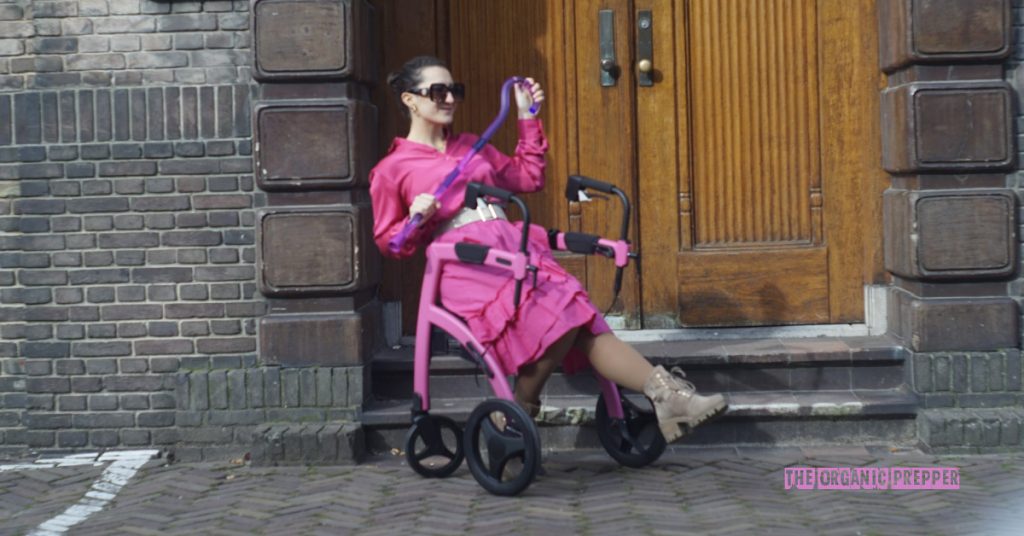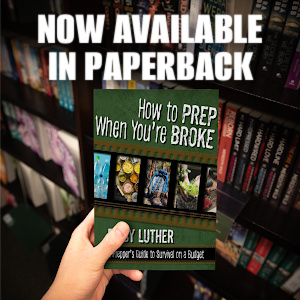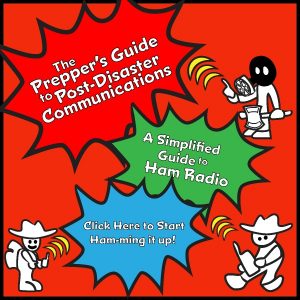If you're new here, you may want to subscribe to my RSS feed. Thanks for visiting!
Author of How to Prep When You’re Broke and Bloom Where You’re Planted online course
One of my biggest concerns as a prepper when I became disabled was “escape.” I’ve always been a walker – miles and miles a day – and suddenly, I’m limited to just a few minutes at a time over very smooth surfaces. How on earth would I bug out or flee violence like that? What mobility aids would help me the most?
Well, the real answer is not one you may want to hear if you’re in my orthopedic shoes.
It’s a whole lot harder in most chaos and impossible in some.
But, I’m no quitter, and neither are you, so let’s look at some of the possibilities. If it’s a life or death matter, you’ll give it your all.
Now, keep in mind, what works for me may not work for you. I am ambulatory, and this ONLY covers the things I’ve tried for my unique situation. I have bad days and better days. I won’t be running any marathons anytime soon, but I strive to get out and move as much as I can.
Canes
I use canes on a daily basis. Inside my home I can get around without it, though I do rely on some furniture surfing from time to time if I’m on my feet for a while. I have quite a collection of these, some geared toward different purposes.
I always have a folding cane in my large cross-body purse.
I worry about something happening to my cane so I always keep extras kicking around. While I don’t find these specific canes as useful as my everyday cane, I keep folding canes in my car, purse, bug-out bag, and my suitcase when I travel. Just like any other prepper, I want a backup as well as a backup for my backup.
Most folding canes have these T-top handles, which aren’t my favorite for everyday use. But in a pinch, they’d definitely be better than nothing. I’ve also come to realize that these could come in handy in any first aid kit. If you were bugging out and someone twisted an ankle, it would be pretty useful.
These canes come in a wide price range. I prefer to look for ones that have high reviews. I’ve paid as little as $7 and as much as $30. You don’t want to get something with bad reviews because the only thing worse than needing a cane to get around is having the cane you’re using to get around break or be unsteady.
I have an everyday cane that supports me well for errands and such.
For daily life, the cane I use the most is this one. The offset handle is easier on my wrist and provides for better balance. I also like the “all terrain” tip on it. This kind is a little better on damp surfaces or other perilous conditions.
For more treacherous areas, I have a very stable cane with four legs.
If I had to go for a longer distance someplace really bumpy, the best I’ve found for it is this “quad cane.” It’s the one I graduated to first when I started using mobility aids. It takes up a lot more space, but the legs provide a great deal of stability.
I also keep a supply of replacement grips (these fit most canes) and a stash of extra tips for when the original one is worn down and no longer safe.
Rollators
One of the things that has provided me with a more significant return to normalcy is a rollator. For longer outings, particularly ones where there could be a lot of standing, a rollator is the best solution for me. I have this one.
For walking, it’s sort of like pushing a shopping cart, so it provides some added balance and stability.
But where it really shines is that it has a seat. Standing in line for more than a couple of minutes is nearly impossible for me. (I walk way better than I stand.) If I know I’m going on a longer outing, I also know I’ll need to sit and rest frequently. If I were to try to sit on the ground, or someplace low or unstable, getting back up is going to require a crane and an act of Congress. With a rollator, I have my own seat with a backrest for times like this.
I don’t need my rollator at home, so it lives in the trunk of my car. This way, if I were to experience car trouble or an accident, I’ll have it with me and be able to use it for both sitting and stability.
The downside to a rollator (at least the one that I have) is that it’s only really good on smoother surfaces. It’s not at all helpful for curbs or stairs, and it also needs to be folded up to go into my vehicle. It weighs around 20 pounds and does fold up pretty easily. My bigger issue is that it’s fairly useless on gravel or bumpy ground. If I have to push with all my might, I’m going to wear out way faster.
I hope to graduate to a fancy off-road one eventually, but those babies are very expensive. According to reviews from physical therapists, it’s one of the best you can buy. It would be really nice to have a way to go out hiking (at least in a modified way) once again.
Carrying stuff
I find that with either a cane or a rollator, the easiest way for me to carry things is hands free. I use a backpack or cross body bag for anything I need to bring with me. Many rollators come with bags or baskets of their own. At the store, I can put one of those little shopping baskets on the seat of my rollator.
You’ll need to experiment and see what works best for you.
Do you use mobility aids?
Mobility aids have really helped to reopen some doors for me and allow me to slowly return to a more normal life. I’ve realized how important these are for daily living, but in a crisis, they could be the difference between living and dying. I may not be able to move fast, but at least I can move given the right assistance. Trekking poles are next on my list of mobility purchases once I’ve built up a bit more stamina.
You have to think about the terrain you are most likely to experience when bugging out or moving without a vehicle when making your choice.
Do you have a mobility aid that you swear by? Have you had any luck with the ones mentioned in this article? Please share your recommendations and thoughts in the comments section.
















19 Responses
This came at just the right time for a trip with my 80 year old mom. We plan on going to TN for some sights & while she can walk (with many stops due to inflammation in her knees), some of these will be great to take along.
Thank you!
I too use a cane for the majority of my mobility issues (23 years in the military takes a toll on the body). Like you I have canes, backup canes and backups for the backups. I have recently started using a sword cane as my primary. They can be pricey but it covers 2 in 1 items (mobility and protection). Downside is I wouldn’t try to get on a plane with it as TSA will run your can thru the X-ray machine.
I’m not sure if it counts, or is on the same level, but I’ve got a blown-out knee from my time in the military. Torn cartilage, severed ACL. Yes, they fixed it as best they could at the time, but that was 35 years ago. On a normal day I get around not too bad – hardly a limp, but for anything strenuous I always make sure I have at least one good brace with me when I’m away from home. I also carry a cane in the truck with me – just in case.
The worst part for me is that you just never know when it’s going to decide to act up. If I plan to do a lot of walking, or any strenuous work around the farm I make sure to put the brace on beforehand. What always gets me is the “normal” days when you really aren’t doing anything, and then a small, insignificant twist or slip has you on your backside, unable to walk for the rest of the day.
I have had bad feet for many years, crutches work best for me. With two I can get almost all the weight off my feet and using one is more stable than a cane if your hands are not real strong.
My husband needed a cane, a walker, and a transport chair. Since I was the primary caregiver, and am elderly, I got things that were as lightweight as possible to make it easier to move things in and out of the car. Since we had a multistory house, I had multiples of the cane and walker. One on each level, since it would be dangerous to try to drag a walker upstairs. I kept a folding walker and the transport chair in the car.
Many senior centers loan items. I was lucky and lived near the Eutrusco Foundation. They also loan all kinds of items. For the things that you buy, I suggest keeping them if you have space. Several of us have used the cane which originally was my father’s.
Thanks, Daisy! I appreciate your take on this topic. I think I’m much like you but worse. At home, I use a Hoveround in the house, and a mobility scooter to get around our 7 acres. My rollator is a Piper model with “Evolution Walker” printed across the seat. What I adore about it is the BIG basket on it. I can carry a big load of laundry in it, or lots of groceries. My nurse friend who has mobility problems says always purchase a bariatric model of equipment because it is sturdier and more long-lasting. I keep a great cane hanging from my rollator to help me get from trunk of the car to driver’s door once I load up the rollator. I have canes EVERYWHERE but the one I love best has a soft, squishy handle. Handle and tip glow in the dark, too. The squishy handle is great for my arthritic hands. I have every style of cane, for different uses. I love Thermacare heat wraps for when I’ve done too much. Apply to whatever aches. I sleep on a heated mattress pad, but take a heating pad in my carry-on (only!) bag when I travel. I have rheumatoid arthritis as well as a number of spine and shoulder issues, so it takes a lot to keep me somewhat mobile.
Hi Daisy. My mobility issues are cause by CRPS so my mobility needs vary from day to day, and that has given me 12 years to adapt. I have a cane with me always, I prefer a wood cane with the Shepherds Crook kind of handle, but also have the type you mentioned that you prefer, as well as a Bubba Stik, look it up, because melee happens. Another cane that I’ve found to be helpful is a cross over from a trekking pole. It’s basically a telescoping trekking pole with a cork wrapped T handle cane handle at the top. Game changer for any uneven terrain. It’s my go to at the beach, the basket keeps it from sinking too far into the sand. I also have an ultralight offroad wheelchair with basically bike tires on the back and that has come in clutch when walking isn’t a realistic option. And when you can walk but can’t carry weight well, you can use it for stability and put a heavy load in the seat.
My wife was diagnosed with MS +30 years ago. It went into remission immediately but came back after our youngest graduated high school. She has drop-foot (common in MS) and a cane is not possible. She is very petite (105#), but was very strong until recently. She needed a rollator.
For all the spouses, family or caregivers: independence is critical for previously super-active people that now have a mobility disability. They are not rejecting your help; they just want to do things on their own, and when they want, just like before. If you are like me, and hover over them, get things for them, or go everywhere with them, you will become a PITA to them. I know this from experience.
My wife fell down steps and broke her neck. Her C1 is fused so she can’t turn her head left or right. No more driving. I wasn’t home when it happened and became super-protective of her. She would tell me of her challenges and I would come up with a solution. That made it worse. I am a ‘fixer’, but she wanted understanding. That was hard for me to understand because I am a FIXER. Go to youtube and search “It’s not about the nail” and you will understand this perfectly. It’s a comedy sketch about this problem.
A 20# rollator was not a solution for my wife because it’s too heavy for her. She wants to grab it and go for a walk around the neighborhood. She wants to walk across the park grass or dirt roads with grandkids. She wants to go without me. I am working up to that part…
She got the Carbon Overland by Acre Daisy mentioned. NOT CHEAP. We bit the bullet so she could do all those things mentioned.
Mobility restrictions are as much about mental health as physical health. Hope this helps.
How does the Overland do when you aren’t on smooth pavement? I’m really hoping for a walk in the woods again one of these days and would love to hear your assessment of it.
It works really well on a very broken, pot-holed, uneven alley behind our house. It also has worked well on a lawn that has nasty truck ruts from the arbor that took down several trees last fall. She is very happy with it. I think part of the reason it does well is the tires are fairly large and inflated, so they roll more easily over stuff in your path. Several of the roads in our small town are uneven, cracked, and pot-holed. She is good on all of them. She feels safe with it and that is huge because she couldn’t go anywhere without me or one of our kids previously. And when you have drop-foot, walking arm-in-arm with someone is only slightly better than alone because you will still trip but the other person has to tighten around your arm. With the Overland, she is in control and can recover very fast because she has both hands on it and can hit the brakes quickly.
Howdy. I’ve got meniere’s disease which is an inner ear problem; it got active after my truck slid off a road w/ black ice. When it’s active I stay at home, find something to do sitting down until it improves. After reading this article I looked online for a narrow rollator, and over time I’ll look again. Some years ago I got a quad cane which works well when the sx are mild enough for ambulation. Some snacks are kept near the computer and things used often are placed nearby.
For all of us, over time, we adjust to our problems and find ways of getting things done. God bless.
My son has mobility issues and we have found the ‘Alinker’ https://www.thealinker.com/ to be very useful. It allows him to take the weight off of his hips, back and lower body while he swings his feet to move forward. The brakes are very helpful when he wants to go too fast (he’s developmentally delayed and doesn’t understand a big ‘crash’ would hurt!). The front wheel allows him to go off roading on trails and yet smooth sailing in tight shops and small towns. Take a look, it might help!
When I first started using a cane (2001), it was like the one you use. When I tripped and fell, with my cane going flying, I decided to buy a heavier one for more stability. I bought a bariatric cane, which is the same size, but much more heavier. If I start to slip, it supports me much better and helps to keep me upright. It also makes for a formidable weapon if needed.
When we lived in snow country, I also bought a cane accessory that goes over the bottom of the cane and has fold-down teeth that digs into the ice to help keep you from going down. You fold it back up when you go into a building, then back down when you go outside.
After I had emergency surgery and was bedridden for 10 months, it took me awhile to get walking again. I used a rollator like you have to start out with; but it didn’t work out for very long. I also have arthritis in my shoulders, and no matter how high I raised the handles, it still put too much pressure on my shoulders.
So I ended up switching to an upright rollator, where you walk along standing upright with your forearms in the arm rests while you are guiding it with your hands. I got it to relieve the pain in my shoulders, but was surprised at how much better my back felt using it (disintegrating spine). I used it at home and in town, although it can be a pain to load and unload from a vehicle.
I got mine from Walmart, which much was cheaper than the ones advertised on TV. I’ve had it for over 5 years now.
I am looking to buy a new one that they have that is made for “all terrain” walking with fatter wheels. ($180) I live on an acre of desert with a gravel driveway, and regular walkers don’t move that well through the gravel. This is the link for that one: https://www.walmart.com/ip/ELENKER-Upright-Rollator-Walker-All-Terrain-Stand-up-Rolling-Walker-10-PU-Wheels-for-Senior-Blue/3496671112?filters=%5B%7B%22intent%22%3A%22fulfillmentIntent%22%2C%22values%22%3A%5B%22Shipping%22%5D%7D%5D
Thank you Daisy, and other commenters. You’ve given me some good ideas. In an emergency I have 3 family members with serious mobility issues that I’ll need to assist.
I do have the Acre rollator and it is very nice. But it is the same on bumpy surfaces as you describe with the rollator you have. I like that with the pull on the center of the seat I can collapse it instantly to fit through narrow passages. And it is very lightweight. I just checked them on Amazon and see they now have a wider one than the one I have. I may have to get a second one. I can keep my original in my car for when I need it and use the new one to get around in my house.
As far as trekking poles you might want to consider ski poles. You can often find them in thrift shops (by the dozens) during the winter. For me, they don’t work because I am very unbalanced. I need the cane or my rollator.
I don’t yet need mobility aids, but I’d be screwed without my readers. I buy multipacks and I have them stashed around the house, in my car, in my desk at work, and in several bags I use regularly. I’m probably not far from hearing aids, either, but I’m hoping for price drops before I look to those. Think of your mobility aids as just another support to help you- most of us need something! I hope you’re out trekking soon.
I only use crossbody or a backpack hung one a shoulder. Sometimes I can carry a backpack on both should but not always. I often use a cane. I own but seldom use a walker with a seat and a transfer hair. Due to old shoulder injuries I cannot use a wheelchair. If I can’t walk then someone must push me. Even on good walking days it’s just limited time standing to garden or can food ect. I lean on a shopping cart in a store and still avoid the handicapped carts.
I can drive ok but no longer climb mountains or follow interesting trails. I force myself to walk this land as much as possible. It’s steep, rugged and rocky. A backpack and a trail will no longer be my escape route. My only route to the mountains would be on someone’s 4×4 ride or my 4×4 truck. A quiet little know spot with a garden, a well, workshop, greenhouse, and solar power with 2 supplimental 800w wind generators is my best answer.
Yes I keep a to-go-bag and in the truck a get-home-box. I still take 0 meds and do my own PT for the shoulder that occasionally wants to freeze up. But the years are catching me.
Thanks for posting this. I love that rollator. Imagine blinging up the off road one, with like pink camo and rhinestones. Right now I have a walker and my hubby using it more than me lately, because he fell in the closet a few weeks ago. …needless to say pointy toe cowboy boots and tequila birthday shots did not sit well with his 70 year old self. 😂
Thanks again Daisy for posting these awesome resources for us folks with mobility issues. I’m going to see about getting that rollator
Due to rheumatoid arthritis (caused by vaccines), sometimes I need a walking stick. The T-type hiking pole is the best, as it gives you more surface area for your hand compared to regular hiking poles. the 3rd cabe looks like “old people”
saludos!